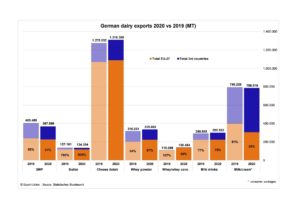The German dairy export business showed mixed results in 2020, depending on the product but also depending on the customer orientation. The larger the share of large consumers such as hotels and restaurants in the target country, the greater the declines due to the consequences of the pandemic. For example, the exports to Italian more or less came to a complete standstill for a while, but has since improved n somewhat. More difficult sales conditions combined with internationally stable raw milk quantities also put pressure on the price level. In accordance with supply and demand, lower prices had to be accepted in export in order to be able to sell the product quantities. This can also be seen in the course of international quotations. However, not all changes can be seen as a consequence of the pandemic. Depending on the destination, demand for certain products also varied greatly due to other external influences, such as public tendering procedures.

For German cheese, a volume increase was also achieved in 2020 despite all adversities. More than 1.3 million tons (+ 2.7 per cent compared to 2019) were sold worldwide. Most of this, 1.08 million tons, remained in the EU, which corresponds to a volume increase of 1.67 per cent. But German cheese also remained popular in third countries. Exports totaled 222,000 tons, 8.5 per cent above the previous year. Italy remained Germany’s most important trading partner for cheese, despite a decline of 3.5 per cent, with 235,000 tons. The Netherlands, however, caught up by 10 per cent last year, although the now 170,000 tons show a considerable gap to Italy. France, Austria and Belgium also showed greater interest in German cheese. Even exports to the United Kingdom increased slightly to over 69,000 tons despite all the circumstances. Outside Europe, the North African countries of Algeria, Morocco and Libya in particular showed greater demand, while South Africa was more restrained. Exports to the USA fell from 10,000 tons in 2019 to 6,700 tons. This is probably less due to the pandemic and more a consequence of the punitive tariffs on European goods. More cheese was also sold to the Asian region. Japan again proved to be a partner with stable growth. Imported quantities of German cheese now amount to about 27,000 tons (+ 28 per cent).
For butter, on the other hand, the year was not quite as pleasing. Although a slight increase in sales volumes was achieved within the EU, as third-country exports fell by 20 per cent, the volumes sold outside Germany remained two per cent below the previous year (137,000 tonn) at 134 ,000 tons. Within the EU, less was ordered in particular by France, the Netherlands, Denmark and Great Britain. Exports to the US halfed to just 500 tons. Butter exporters also suffered considerable losses for the United Arab Emirates (from around 6,000 tons to 675 tons) and for Japan (from 2,000 tons to 530 tons).
The export volume of SMP fell by a sensitive 10 per cent. In 2019, it was still 405,000 tons that crossed German borders, but in 2020 only 368,000 tons. It should be noted here that due to the removal of SMP from EU intervention, larger quantities of previously stored goods were released onto the market. For the African region, losses amounted to 24 per cent and were caused in particular by lower volumes to Egypt, Algeria and Nigeria. In the Asian region, less skimmed milk powder from Germany was needed in China, Vietnam, the Philippines and Saudi Arabia, as was the case in the Dominican Republic.
Sales of milk and cream in consumer packs of less than 2 litres did suffer a slight drop of one per cent overall (2019: 795,000 tons/ 2020: 787,000 tons). Around 100,000 tons were missing from trade within the EU, with 75 per cent of the decline falling to the two countries Denmark and Belgium. In contrast, 40 per cent more liquidg milk was delivered directly to China (367,000 tons). Overall, more German liquid milk was sold to third countries than within the EU for the first time.
photo: pixabay



